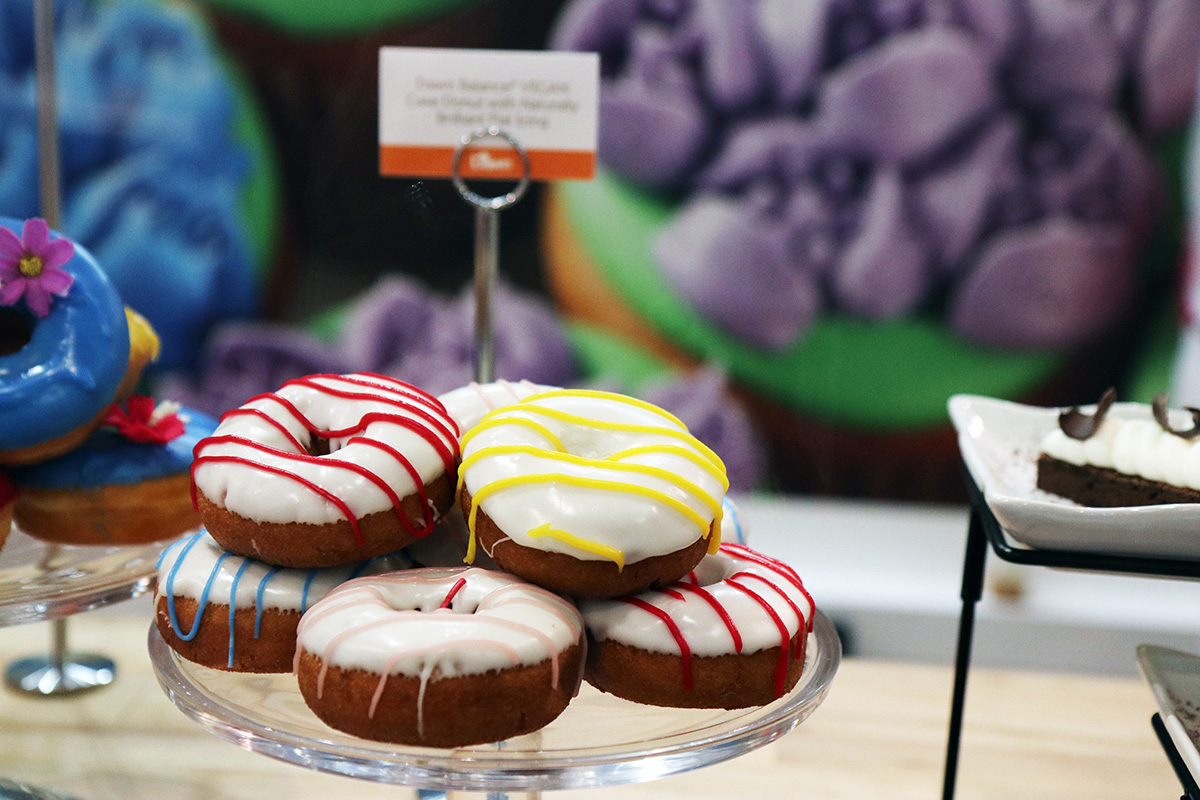Clean label remains a critical but broad topic. Sharpening the future direction of the movement will play a significant role in how the industry succeeds. While specifics are still being worked out, a growing number of bakery ingredient companies and bakery retailers are now moving forward with sweeping projects and product line extensions that already drive higher awareness and consumption for clean label bakery.
“While the definition of ‘clean label’ is still up for grabs and even a bit misunderstood, consumers want simple, trusted and easy-to-understand ingredients in the foods they choose,” says Nicole Rees, product director for AB Mauri North America. “We’re in a second wave of clean label, where ingredients chosen are just step one. How they were produced and processed is now being questioned. Essentially clean label is now also about processing.”
Bill Hanes, vice president of marketing and strategy for Lesaffre, shared that a recent report from L.E.K. found that more than 60% of consumers look for products with labels reading "no artificial ingredients," "no preservatives," and "all natural."
“We offer clean label dough improvers and shelf life extenders that also benefit the quality and longevity of the eating experience for consumers,” Hanes said. “Noteworthy successes include extending the freshness of a shelf-stable snack cake from 30 to 45 days and doubling the lifespan of a yeast-raised doughnut from 18 to 36 hours.”
Clean label can cover many areas — organic, non-GMO, shorter ingredient lists, simplified formulations that include only the ingredients people find in their kitchen cabinets, or free from artificial preservatives, colors and flavors, explains Kathy Sargent, director of global market strategy for Corbion, headquartered in Lenexa, Kan. That openness to interpretation adds to manufacturers’ challenges in pursuing the clean-label opportunity, but it also gives them room to do it in a way that resonates with their target customers. And clean label continues to be a term that encompasses a lot and is interpreted differently by consumers of all ages.
Because the definition of clean label can be different depending on whom you ask, the needs of suppliers can vary widely when it comes to incorporating it into their product lineups, Sargent explains. When Corbion works to help a customer implement cleaner labels, “we always start by understanding their brands and consumers, identifying their operational and formulation challenges, and figuring out what ‘clean’ really means for them.”
The new “free from” game

Rees of AB Mauri North America explains that consumers are monitoring the situation and basing their purchasing decisions on a variety of factors.
“Unless cost is a factor, consumers expect the baking industry to use the cleanest, simplest ingredients possible,” Rees says. “Again, while clean label has been an important driver in food products across the board – including baking – it is important to note that the consumer expectation of customization has changed the shopping landscape. People expect to find products that match their dietary and nutritional preferences. This change transformed clean label into a ‘free from’ game.”
On pack messaging advertises no artificial additives, colors or preservatives; grain free; no MSG; BPA free; no high fructose corn syrup; and more, she explains.
Of all the label claims, consumers tend to trust third-party certifications, such as organic and Non-GMO Project over health claims, Rees adds.
At Dawn Foods, Elena Taylor, senior director, wet ingredients, offers that one of the most common ways that consumers are making decisions is by reading the ingredients label. This sounds simple, but it is one of the quickest ways for a consumer to determine if a product is “clean.”
To make this easier on their customers, Dawn recommends bakers make ingredient lists and nutrition facts readily available within their stores and online. Certifications from third-party sources – like the Clean Label Project – are also important, she says.
“Our current priorities are to expand our offerings of clean label items with natural preservatives and to ensure we anticipate shifts in the clean label space so we’re able to promptly address consumer needs,” Taylor explains.
A simplified response
In order to help customers achieve their clean-label goals, Corbion offers a variety of solutions that appeal to consumer demands for simplified, cleaner ingredient labels. Corbion continues to invest and innovate in the clean-label space, creating products that solve for a wide range of baking challenges.
“These solutions range from ensuring freshness with our Ultra Fresh® and Ultra Fresh® Sweet technology, preservation and natural mold inhibition with Verdad®, to clean-label dough conditioning with our Pristine® line products,” Sargent explains. “In addition, all of the palm oils used in Corbion products are now RSPO-certified and come from suppliers committed to minimizing negative impacts on palm-growing regions and their communities. We believe this change is especially beneficial for bakers as clean-label demands continue to shift toward greater transparency and sustainability.”
AB Mauri continues to look at a wide range of bakery ingredient solutions that meet what both AB Mauri’s customers and their consumers desire, from cleaner label options that make a product label more recognizable to ensuring bakers can highlight the positive benefits of their products.
“For example, our Burgen line of bread mixes go beyond the basics of simple ingredients and nothing artificial with positive health benefits. Even our white bread brings invisible nutrition to the table, naturally, by utilizing flours inherently rich in heart-healthy soluble fiber,” Rees says. “We want to change the conversation to talk about what’s good about the ingredients and not just what isn’t in there.
Bringing science to forefront

Malt Products Corporation, a manufacturer of malted barley extract and other natural sweeteners, has designed an Innovations Lab to help its food and beverage industry customers test ingredients, experiment with new formulations, and gain insight into critical flavor and stability properties. The lab will be utilized for a wide variety of products, including baked goods, malt and oat-based beverages, creamers, nut butters, chocolates, confections, as well as further the company’s push into the burgeoning plant-based proteins sector.
“We want to make it as easy as possible to prototype new products with healthier, pantry-friendly ingredients, and for our customers to understand these products’ mission-critical characteristics,” said Amy Targan, president of Malt Products Corp.
Taylor at Dawn Foods explains that a clean label product is generally recognized as having simple ingredients that contain no artificial ingredients or additives. Although there is no singular definition, Dawn has found that consumers tend to associate clean label products with health and sustainability.
“At Dawn, we are always looking for ways to expand our clean label offerings, especially with natural preservatives, she explained. “Dawn’s Balance Cleaner Ingredients products are free from artificial colors, flavors, sweeteners, partially hydrogenated oils and high fructose corn syrup.”
Dealing with specifics
Over the past decade, AB Mauri has worked hard to develop solutions to replace traditional emulsifiers with chemical-sounding names, such as diacetyl tartaric acid ester of mono- and diglycerides (DATEM), sodium stearoyl lactylate (SSL) and mono and di-glycerides, Rees explained. “As we’ve responded to consumer preference, many of these systems needed to be revamped into organic or non-GMO certified versions.”
Rees explains that sustainability is the third wave of clean label, and ‘it’s gaining traction every year. These younger consumers aren’t afraid of food technology that helps the planet, but they expect transparency and data.”
Taylor of Dawn Foods says that while the shelf life of individual products varies, the goal for natural preservatives is to achieve the same shelf life as conventional items. Dawn’s research and innovation team continues to invest in the natural preservative space.
“We have developed the capability with our cleaner ingredients to achieve a similar shelf-life with natural preservatives,” Rees said. “We recently launched a line of fruit and cream fillings with natural preservatives. Our next longer-term goal is to expand this natural preservative technology to other categories including icings.”
Research-supported actions
Amid a consumer push for more natural ingredients, Malt Products regularly helps customers reformulate food and beverage products as they turn away from artificial or non-nutritive sweeteners. The company’s portfolio of pantry-friendly sweeteners includes MaltRite malt extract, OatRite oat extract and CaneRite sugar cane molasses. MPC produces both dry and liquid sweeteners.
Located in the company’s Minneapolis office, the lab incorporates a variety of recent infrastructure investments including ovens, mixers, shearers, proofers, and temperature-controlled incubators, as well as analytical equipment such as spectrometers and instruments monitoring water activity and rheology. It collaborates with MPC’s main manufacturing facility in Dayton, Ohio, to help customers expediently transition from development to production.
In addition to all natural, many of MPC’s sweeteners contain health benefits such as proteins and antioxidants. For baked goods, many can assist with the Maillard reaction for attractive browning and can protect shelf life by controlling viscosity. Malt extract in particular is also an attractive ingredient for the exploding non-alcoholic beer market, serves as an excellent base for fermented drinks like Kombucha, and supports the viability of probiotics in specialty teas.
Malt Products’ new space is a combination analytical zone and kitchen for product development and testing, sensory evaluation and shelf life testing, allowing food & beverage companies to branch out into new ingredients and flavoring possibilities. The lab also features office space for meetings, problem solving, and interactive product and business development.
“As more food and beverage companies look to revamp their products using all-natural ingredients, the new Innovation Lab provides a hub for formulation experimentation, testing the viability of various ingredients regarding flavor, binding, shelf life and other critical factors,” Targan said.
What’s new with snacking?
Flavorchem revealed some of the most prominent bakery and snack trends:
Functional Foods: The heightened health awareness has many consumers seeking decadent better-for-you snacks that still provide nutritional benefit. Plant-based alternatives, herbs, and other functional ingredients with perceived health benefits are conventional snack aisle staples.
Anxiety Baking: DIY consumers are alleviating stress by sharpening their baking skills during these unprecedented times. Yeast, an ingredient commonly used to make bread and other bakery products, saw sales surge by 647% in the week ending March 21 compared to the same week in 2019. Online searches for homemade bread recipes hit nearly 900,000 views with banana bread being a staple pandemic treat.
Comfort Food Takes the Cake: As indulgent bakery sales continue to rise, 79% of consumers admit to purchasing more comfort food now than in previous months. Chocolate is still the top quarantine snack with 90% of shoppers purchasing some form of this treat in the last three months.
Childhood Indulgences: Nostalgic flavors, like cinnamon roll and smores, are gaining traction as consumers re-create experiences that they are not currently able to do. Backyard margaritas and homemade birthday cake creations will trend deep into summer.
Flavor Combinations: Salty snacks featuring confectionery coatings have recently seen a strong level of popularity, with caramel corn and chocolate covered popcorn remaining traditional favorites.




